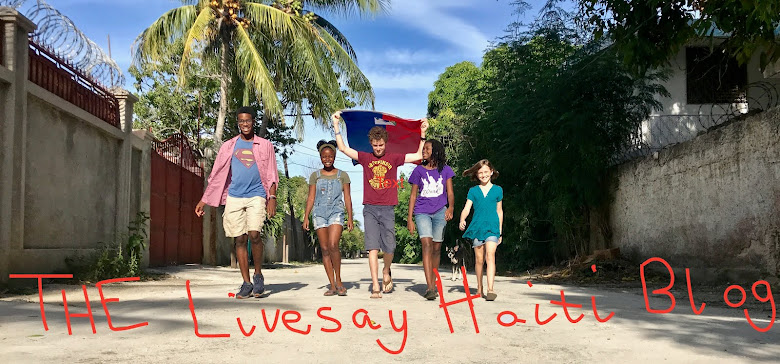Cholera Tent Dynamics
We now have seven cholera tents at the Cholera Treatment Center at Hospital Albert Schweitzer.They are a dirty white and some say UNICEF on the front flap.
We refer to them by their number. And we say “the guy with the IV in his ankle was just moved to “tent five”….brilliant things like that.
More tents are added all the time for the huge numbers of cholera patients that arrive here each day and need to stay for treatment. We send as many people home as possible each day, but the sickest are kept in the building or in the tents.
The smallest tent has about 8 patients and the largest has 25 patients.
Each tent has green cots placed on jagged rocks. And the cots are so close together that one cannot walk between them. To get to a patient who is not far away, one may take a long convoluted route around other people and cots.
Family members tend to their sick loved ones. They change sheets, and empty their buckets and clean them up. They also provide food when the patient can begin to eat.And family members hold IV tubing for me, and I stick tape to their arms near me so I can quickly secure the new IV I just placed.
A Haitian nurse is in charge of one or two tents depending on the numbers of nurses and patients. She is in charge of maintaining IVs and passing meds and seeing if people are still breathing.
These tents have helped save the lives of many hundreds of people during the last several weeks.
But…
When I round in the tents during the day, I cannot stay in the tent for more than five minutes. The heat and humidity are just overwhelming.
After examining a patient or trouble shooting an IV in a tent, I will attempt to chart on the patient’s dossier. And I frequently find myself confused and sometimes don’t even know which page to chart on and sometimes find myself writing gibberish notes.
If I step out of the tent to correct and finish my note, I am ok and can re enter the tent and start on the next patient.
The patients are in the tents 24 hours per day. I have no idea how they do it especially with acute cholera.
These tents remind me of the tents in Port-au-Prince camps that are “homes” to hundreds of thousands of internally displaced people from the earthquake. These tents and camps in the capital are pure hell.
The social dynamics in the cholera tents here at the Cholera Treatment Center are interesting and say a lot about poor Haitian society.
We have one tent just a few feet from the front door of the admission room.It is a small tent that has about eight cots in it. The people in this tent have been quite ill, all hooked up to IVs, and in different states of consciousness. Their family members hover over them and constantly motion to me and say things to me that drive me crazy…but they need to be said. (My mother can’t talk any more, her stomach hurts, her IV is empty, she has a fever, etc.)
When I enter this tent I need to bend down some and when I examine the people along the walls, I have to really bend down or the plunging tent roof pushes against my head.
This tent had one man in the middle who was hooked up to an IV and he would tell me who was sickest and who to tend to first. I lugged in the heavy box of Ringer’s Lactate in each day and placed it at the head of his cot. And he would open the box and then open the liters of Ringer’s Lactate for me and hand them to me as I inched around the tent tending to the patients.
He helped me a lot and made me more efficient. Hanging new bags, changing tubing, removing the air from the tubing, and hooking the patient back up does not sound like much, but it is here. Especially when it is hard to breathe or think.
This man slowly got better and I DC’d his IV and put him on all oral rehydration solution and he could help me even more in this tent. Four of the women in the tent were especially bad all week last week and this patient did quite a job alerting me to their need for more fluid each day. I sent the man home a couple of days ago, because he was too good to stay. No one has died in this tent yet.
This tent with this sick man acting as a valuable cholera assistant is emblematic of Haitian society. The poor take care of their neighbors as much as they can. They laugh when they have the strength to laugh. And I think this “force” that they exhibit to stick together in their villages, cholera tents, or internally displaced people camps, is the number one most important virtue in Haitian society that keeps 10 million people as functional as they are.
Who extricated the most people trapped in buildings after the earthquake? Was it the international community who flooded in to Haiti, the UN, the Haitian government, or poor Haitians?
And who brings sick Haitians with cholera to Cholera Treatment Centers? Is it President Martelly or Baby Doc who came back to help Haiti? Or is it the “blue helmets” in their big white SUVs? Or is it strong Haitian men from “andeyo” carrying the infirm on their shoulders?
We all know the answer.
Haitians have no government to depend on, and the poor don’t “touch” the international money.
If your IV runs dry, don’t ask a politician to hang your next bag. Ask the sick guy on the green cot in the center of the tent.
John A. Carroll, MD
www.haitianhearts.org


